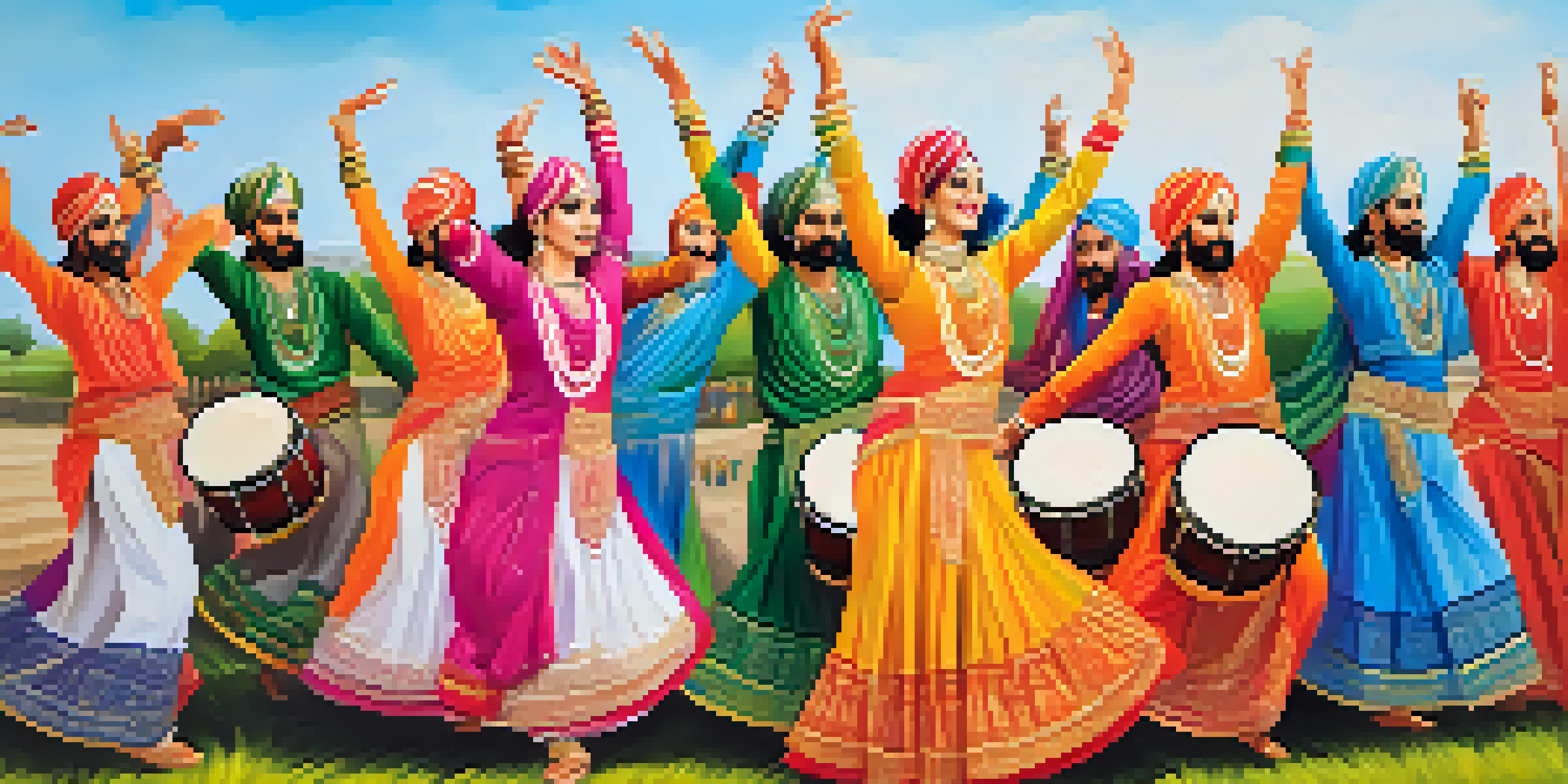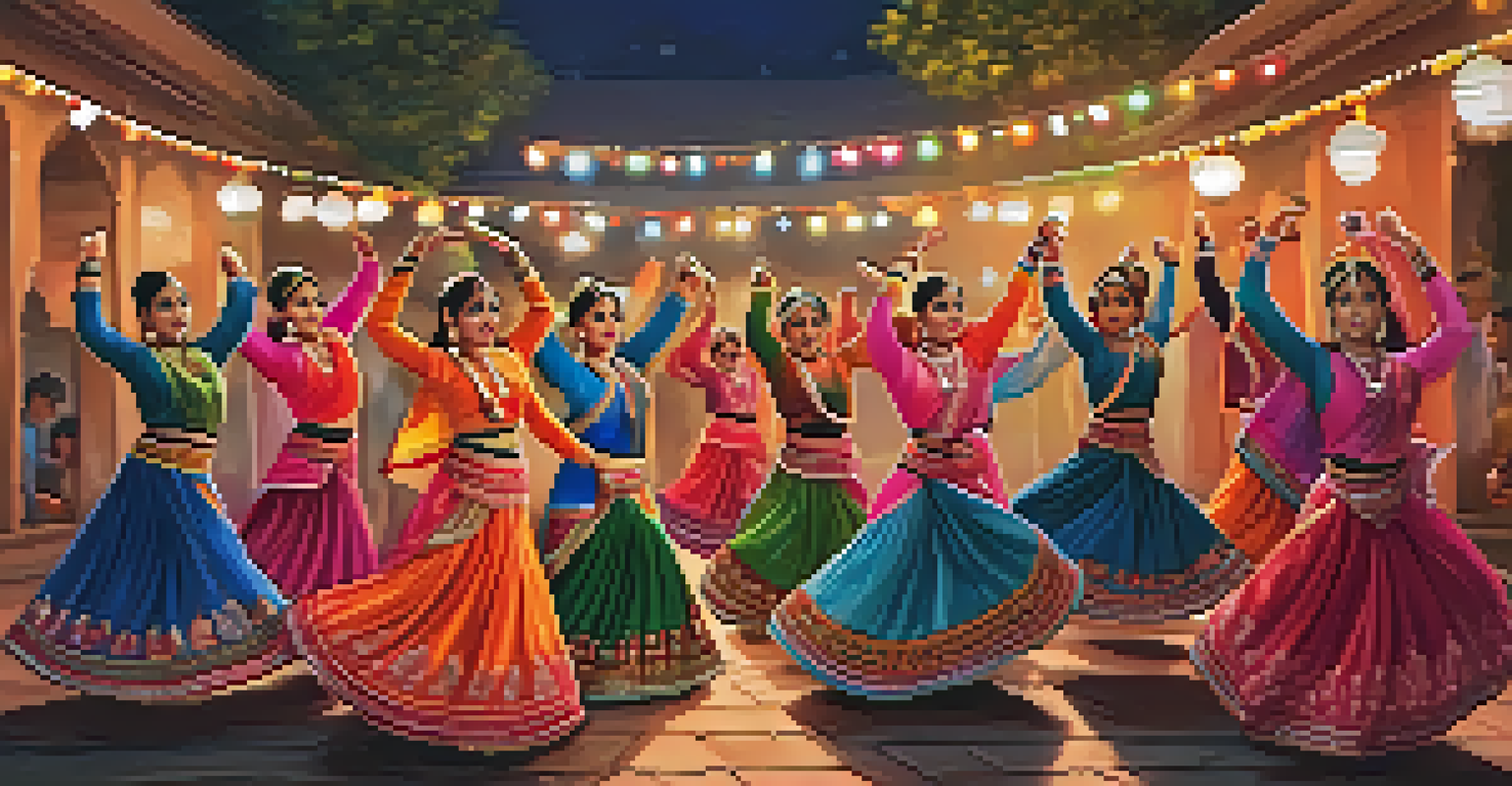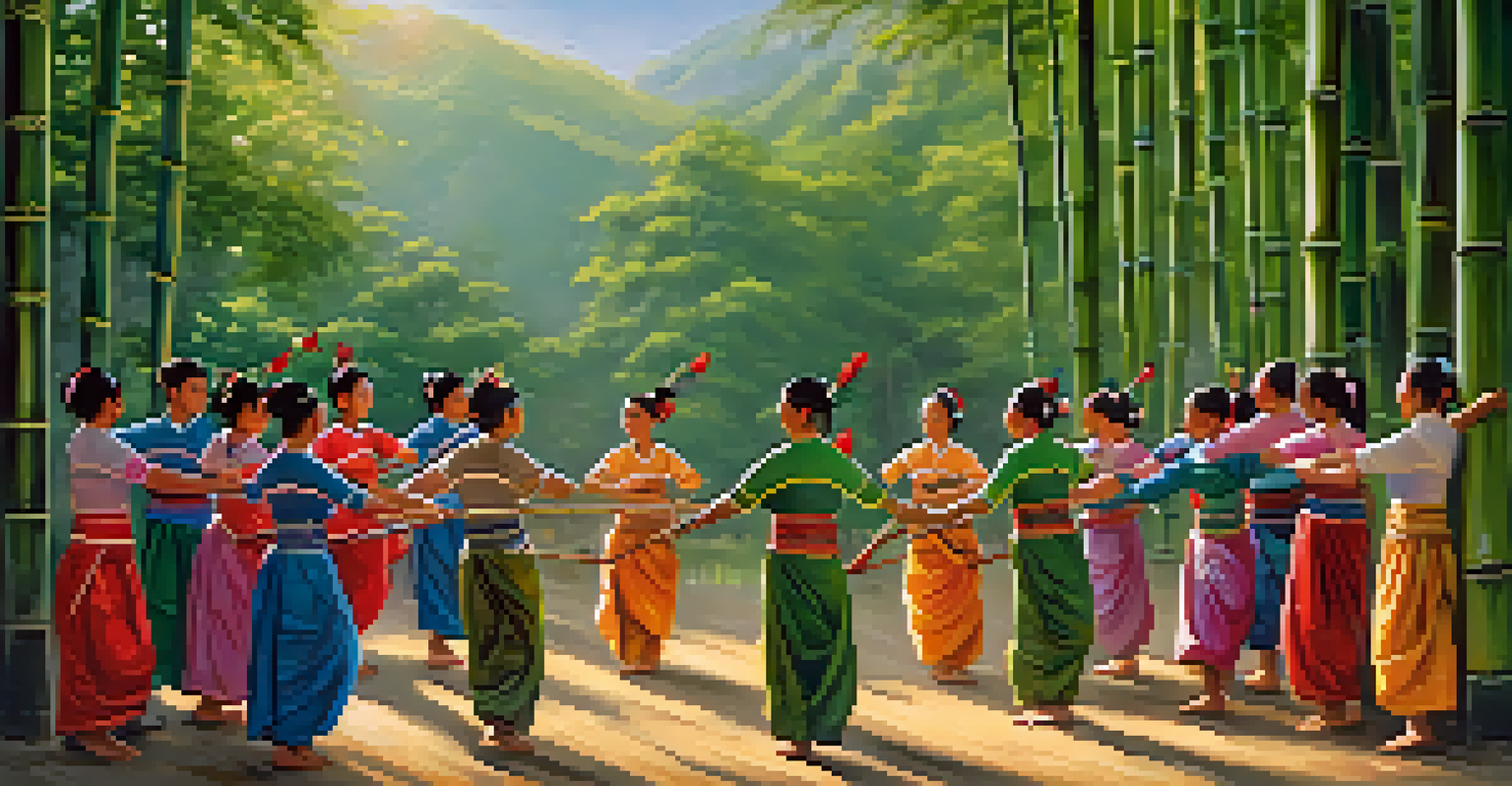Folk Dance Traditions of India: Diversity and Significance

An Introduction to India's Folk Dance Heritage
Folk dance in India is a vibrant tapestry woven with threads of culture, history, and community. Each region boasts its own unique styles, reflecting local customs and traditions. Through these dances, stories of love, joy, and life's struggles are expressed, making them an essential part of India's cultural identity.
Dance is the hidden language of the soul.
These dances are often performed during festivals, weddings, and community gatherings, serving as a way to bring people together. The energy and enthusiasm displayed in folk dances not only entertain but also foster a sense of belonging among participants and spectators alike. It’s as if each dance invites you into a world where history and community converge.
Folk dances also play a crucial role in preserving oral traditions, enabling the passing down of stories and values across generations. As we delve deeper into the various forms of folk dance, we uncover the rich diversity that characterizes India's cultural landscape.
Regional Variations: A Glimpse into Diversity
India's vast geography and diverse populations give rise to a multitude of folk dance forms. From the Bhangra of Punjab to the Garba of Gujarat, each dance showcases the unique cultural ethos of its region. For instance, while Bhangra is characterized by its energetic movements and vibrant music, Garba incorporates graceful circular patterns reflecting devotion.

In the northeastern states, dances like the Bamboo dance of Mizoram highlight the region's connection to nature and community unity. Similarly, the Kalbelia dance from Rajasthan, performed by the snake charmer community, captivates audiences with its fluid movements and colorful attire. This regional variation is a testament to how local customs shape artistic expression.
Folk Dance: A Cultural Tapestry
Folk dance in India reflects diverse cultural traditions, telling stories of love, joy, and community.
Moreover, these dances often draw from local folklore, myths, and rituals, making them even more significant to the people they represent. Each dance tells a story, connecting the performers to their roots and preserving their cultural heritage.
The Role of Music in Folk Dances
Music is the heartbeat of folk dance, providing rhythm and emotion that elevate the performance. Traditional instruments like the dhol, nagada, and flute are commonly used, each adding its unique flavor to the dance. The beats of the dhol in Bhangra can make anyone want to jump and dance along!
Folk dance is a celebration of community and a reflection of cultural identity.
Songs often accompany the dances, telling stories or expressing the sentiments of the local community. The lyrics can range from celebrating the harvest to narrating tales of love and valor. This musical element not only enhances the dance but also reinforces the cultural narratives embedded within them.
The synergy between dance and music creates an immersive experience that speaks to both performers and audiences. In many instances, the music serves as a catalyst for community bonding, encouraging everyone to join in the celebration.
Folk Dances: A Reflection of Social Life
Folk dances often mirror social realities and community dynamics, encapsulating the essence of daily life. They serve as a platform for expressing emotions, celebrating milestones, and even addressing social issues. For many, participating in these dances is a way to connect with their heritage and community values.
In rural areas, dances may reflect agricultural cycles, celebrating planting and harvesting through joyous movements. Conversely, urban adaptations of these dances often blend traditional elements with contemporary influences, showcasing the evolving nature of cultural expression. This adaptability allows folk dances to remain relevant in changing times.
Music Enhances Dance Experience
Traditional music complements folk dances, creating an immersive experience that fosters community bonding.
Additionally, these dances often promote inclusivity, inviting individuals from different backgrounds to participate. This communal aspect reinforces social bonds and fosters a sense of unity, even in a diverse society.
The Impact of Globalization on Folk Traditions
Globalization has brought both opportunities and challenges to folk dance traditions in India. While it has provided a platform for these dances to reach wider audiences, it has also led to concerns about cultural dilution. The challenge lies in maintaining authenticity while adapting to modern influences.
Many artists are now blending traditional folk dances with contemporary styles, creating innovative forms that resonate with younger generations. For instance, the fusion of hip-hop with traditional Bhangra has gained popularity, attracting diverse audiences and sparking renewed interest in folk traditions.
However, this blending must be approached with care to ensure that the essence of the original dance is preserved. Striking a balance between innovation and tradition is key to keeping these rich cultural expressions alive in a rapidly changing world.
Preservation Efforts: Keeping Traditions Alive
Efforts to preserve folk dance traditions are crucial in maintaining India's cultural heritage. Many organizations and cultural groups are actively working to document and promote these dances, ensuring they are passed down to future generations. Workshops, festivals, and performances play a vital role in keeping these traditions vibrant.
Educational institutions are also recognizing the importance of folk arts, incorporating them into curricula to teach students about their cultural roots. This not only fosters appreciation but also encourages active participation among the youth, who are vital in carrying these traditions forward.
Preservation of Traditions Matters
Efforts to preserve folk dance traditions are essential for maintaining cultural heritage and passing it to future generations.
Moreover, local communities are increasingly aware of the value of their folk dances, leading to grassroots initiatives aimed at revival and preservation. Through these collective efforts, the spirit of folk dance continues to thrive, enriching India's cultural landscape.
Conclusion: The Significance of Folk Dance in India
In conclusion, folk dance traditions in India are more than just performances; they are a living testament to the country’s diversity and cultural richness. Each dance tells a story, connecting individuals to their history, community, and values. These dances are a celebration of life, reflecting the joys and challenges of daily existence.
The significance of folk dance extends beyond entertainment; it fosters social cohesion and cultural identity. As we engage with these dances, we not only honor the past but also pave the way for future generations to experience and appreciate their heritage.

Ultimately, folk dances remind us of the beauty of diversity, inviting everyone to join in the dance of life. As we celebrate these traditions, we contribute to a legacy that binds communities together and enriches our shared human experience.